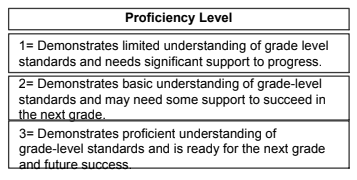In a traditional grading system, students receive a single letter grade (A–F) for each subject. That grade often combines test scores, homework completion, participation, and behavior—all into one average. While this can give a general sense of performance, it doesn’t show which specific skills a student has mastered or where they may need help.
A standards-based report card breaks down each subject into key learning standards and shows how well your child is progressing in each area. Instead of a letter grade, you’ll see a 1–3 scale that reflects their level of understanding for each skill. This helps:
Clearly show what your child knows and can do.
Identify specific areas of strength and growth.
Focus on learning, not just grades.
Think of it as a more detailed, skill-by-skill snapshot of your child’s learning—designed to guide instruction and better support their success.
Our Standards-Based Report Card uses a proficiency scale to show how well your child is meeting grade-level expectations for each skill. Instead of letter grades, you’ll see numbers—1, 2, or 3—that provide clearer insight into what your child knows and is able to do.
Here’s what each number means:
1 = Beginning Understanding
Your child is just starting to learn this skill and needs significant support to make progress.
2 = Developing Understanding
Your child shows a basic understanding of the skill but may need some support to be successful at the next level.
3 = Proficient Understanding
Your child meets grade-level expectations and is ready to move on to more advanced learning.
Note: A "3" is the goal—it means your child is right where they should be!
We're focusing on growth and mastery, so your child may receive different numbers in different areas depending on their progress. This scale helps teachers personalize instruction and gives families clearer insight into learning.
Is a 3 like getting an A?
→ Not exactly. A 3 means your child has mastered the grade-level skill. Unlike A–F grades, SBRCs are not about averaging points but about showing progress toward specific learning goals.
Why isn’t there a 4 on the scale?
→ Some schools use a 1–4 scale, but JBE uses a 1–3 scale to focus on core mastery. A 3 means your child is on track and ready for the next grade.
What if my child gets a 1—should I be worried?
→ A 1 means your child is beginning to develop the skill. It’s a signal that they need more support, not a failure. Teachers will provide interventions to help your child grow.
We welcome questions as we make this change - submit any questions you have here and we'll address them in our future newsletters!


